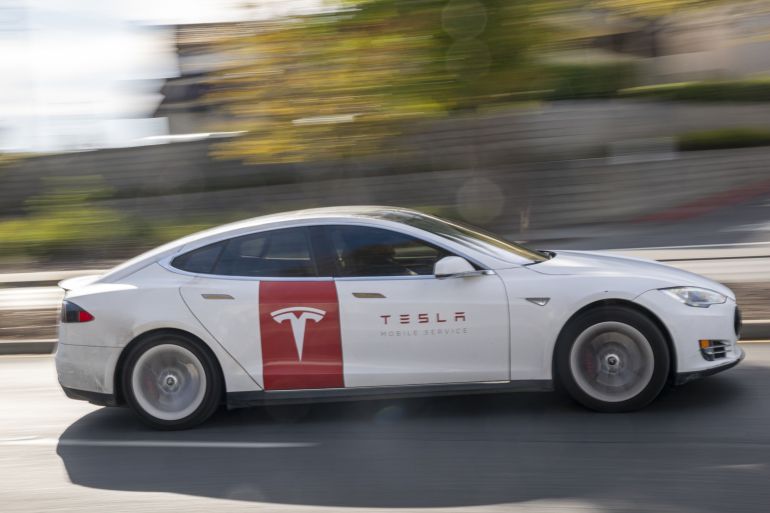Tesla Lowers Prices in China for a Second Time as Demand Declines
 |
| Some Tesla vehicles are now 24 to 32 percent less in price in China than they are in the company's main market, the US [File: David Paul Morris/Bloomberg] |
In addition, Tesla lowers its prices in Australia, South Korea, and Japan while so far maintaining its prices in the US and Europe.
As demand declines in the largest auto market in the world, Tesla has reduced pricing in China for the second time in less than three months, fueling predictions of a bigger price war.
A person with direct knowledge of the plan said that the US automaker also reduced the cost of its best-selling Model Y and Model 3 electric vehicles in Japan, South Korea, and Australia as part of an effort to boost demand for the output from its Shanghai factory, which serves as its main production hub.
The change is Tesla's first significant action following the appointment of Tom Zhu as its chief executive for China and Asia to oversee worldwide production and deliveries, which have been at the center of the company's recent struggles after missing its 2022 delivery target.
In Friday's busy trade, Tesla stock sank 2.5%. In the previous year, the stock's value declined by 70%.
While automakers have historically used incentives to manage inventories, Tesla had been able to maintain or even raise prices because of strong demand up until the end of last year.
Elon Musk, the company's CEO, however, claimed last month that "dramatic interest rate changes" have impacted the affordability of both new and used automobiles, and that Tesla may lower pricing to maintain volume growth.
According to calculations by Reuters, the most recent price cut in China, together with one in October and recent incentives for Chinese consumers, resulting in a 13 percent to 24 percent decrease in Tesla's prices from September in the country's second-largest market after the United States.
Reuters calculated prices based on the website prices and found that Tesla reduced prices for all of its Model 3 and Model Y vehicles in China by between 6 and 13.5 percent. The Model 3's starting price was decreased from 265,900 yuan ($38,661) to 229,900 yuan ($33,427).
Tesla's vice president of external relations in China, Grace Tao, claimed on Weibo that price reductions in China were a result of engineering innovation and a response to Beijing's desire to promote economic growth and consumption.
In December, Tesla's China-built vehicle deliveries fell to their lowest level in the previous five months. Additionally exporting automobiles to Europe is Tesla's Shanghai facility, which was enlarged the previous year.
According to sales statistics from the research firm JATO Dynamics, sales in Europe increased by 93% in November year over year. The Model Y was the best-selling vehicle for the second consecutive year in 2022. However, there have been no signs of Tesla lowering costs there as of yet.
Additionally, Tesla saw a rise in its market share for battery electric vehicles in Europe, from 12.3 percent in November of last year to 18.9 percent in November.
End of Subsidies
Days after Beijing discontinued a program of subsidies, Tesla initiated the price reductions. Tesla and its competitors are being forced to bear the brunt of the change due to declining demand.
According to China Merchants Bank International (CMBI), Tesla may need to take additional steps, particularly as rivalry from its Chinese rivals heats up.
In light of aging models, CMBI analyst Shi Ji stated that Tesla "has to further drop prices and expand its sales network in China's lower-tier cities."
In 2023, Shi predicted, "new EV [electric vehicle] production capacity in China will outstrip new demand."
Popular Chinese auto blogger Sun Shaojun, however, said on Weibo that Tesla's price reductions were so significant that other manufacturers, notably bigger rival BYD, would need to respond.
After the government subsidies ended, BYD recently increased the cost of its best-selling models.
After the price drop, the Seal, a model introduced by BYD in July, cost around $1,000 more than Tesla's Model 3. The pricing of BYD's most popular Han EV and the Model 3 are now equal.
BYD said it will modify its own pricing in response to shifts in the market's demand but declined to comment on that of its rivals.
According to CMBI data, BYD, which sells both plug-in hybrid and all-electric cars, had its retail sales in China treble in December while Tesla's declined by 42%.
Displeased Tesla Owners
Screenshots of social media conversations seen by Reuters revealed that some Tesla owners in China who took delivery recently but were not eligible for the discounted rates announced on Friday that they planned protests at Tesla dealerships in Shenzhen and Henan.
Tesla made no more comments. Tao's Weibo post was recommended to Reuters by a Tesla spokesperson.
According to calculations by Reuters, the pricing of the Model 3 and Model Y automobiles in China are currently 24 to 32 percent less expensive than those in the US. This difference can be attributed to a number of variables, including labor and material costs.
Tesla also reduced the cost of the Model 3 and Model Y in Japan by around 10% apiece, for the first time since 2021.
According to the Inflation Reduction Act, which became law in August, the Model Y and Model 3 are now qualified for up to $7,500 in clean vehicle tax credits in the United States.
Just over a third of Tesla's overall sales in 2021 came from China.
SOURCE: REUTERS
Post a Comment